Aquascaping is one of the best ways to make your aquarium a centerpiece. Proper measures are necessary to maintain your aquarium plants. Here, aquarium plant tools come to rescue the aquarists. They include plant trimming tools to help make your entire plant conditioning easy and fine-tuned. In this article, you’ll learn all about plant trimming, pruning, how to trim the plants, what to do after plant trimming, and many other things.
Content Table
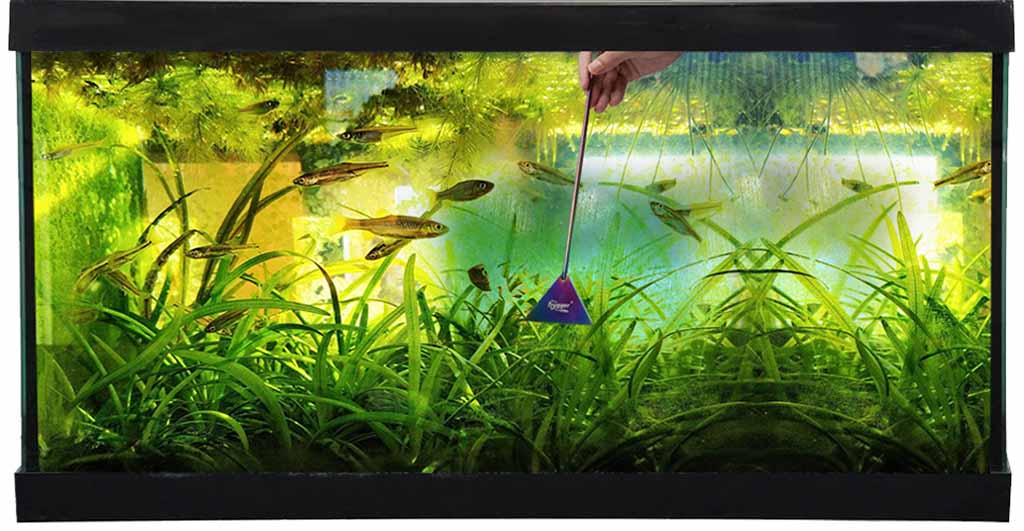
Points to Care For Plants in Aquariums
Plants provide numerous benefits to the aquarium ecosystem. Therefore, it’s necessary to take proper care of them. Here are some points that you need to consider for that.
Light
Light is an important aspect as it controls photosynthesis. Install 6000K to 8000K spectrum light for 6 to 8 hours for proper plant growth. Moreover, light intensity also matters. It varies with the tank size and plant type. However, in general, 2 watts per gallon is enough.
Substrate
A proper substrate is another aspect of aquarium’s plant care. If you are using gravel, then medium size gravel is the best. Sand is good for cleanliness. However, it hinders plant growth due to compact pores. The best option for proper plant growth is soil/dirt as a substrate.
Water Parameter
Water parameters directly affect plant growth. Generally, 6.5 to 8.5 pH, 50-100 ppm hardness, 3° and 8° dKH alkalinity, and less than 10 ppm nitrate 0.5 ppm phosphate level are the most optimal water conditions for plant growth. Change 10% weekly or 25% bi-weekly water in the tank.
Fertilizer Application
The fertilizer application is another worth considering point in plant care. Apply proper aquarium fertilizer for optimal growth.
Temperature and CO2
Temperature and CO2 systems depend on the type of plant. Some plants, i.e., java moss, lilaeopsis, and water wister, require the least CO2. However, 74–80°F is optimal growth.
Trimming
Trimming will help the plants to be in proper shape and take a fair nutrient share. Frequently, trim the plants and remove the dead leaves or unwanted branches by hand or with some plant trimming tools.

Why Trim the Aquatic Plants
Trimming a plant means removing unwanted and excessive branches or shoots to keep your plant in shape. It is among the most important aspects of aquatic plant care. There are many reasons for which you need to trim them. Some of them are in the following.
Reasons to Trim Your Aquatic Plants
- It helps to improve the overall aesthetics of the aquarium.
- Helps to balance nutrient usage, as trained and small plants require less fertilization than untrained and large plants.
- Trimming helps to get fair space for other aqua pets and plants.
- Trimming the plants helps in light spreading.
- It encourages new growth.
Which Plants Need Pruning?
The other one of the most important aspects of plant care is pruning. It involves removing a plant’s dead, loose, and unwanted parts and helps to improve the plant’s health. The following plants require pruning.
| Terrestrial plants | Oxygenates plants | Floating plants |
| Submerged plants | Marginal aquatic plants |
Here is an example of 5 types of aquatic plants that require the most pruning.
Top 5 Aquatic Plants Requiring Extensive Pruning
- Java Moss
Java moss is an easy-to-grow and fast-growing plant. You need to prune them after each week so they don’t overpower the tank.
- Water Lilies
Water lilies are one of the most beautiful and popular plants. They require extensive pruning because they grow at a fast rate. They have large leaves that spread all over the water. Prune dead or decaying leaves and spent flowers. It’ll help to encourage new growth.
- Anacharis
It is another plant that requires extensive pruning. Timely pruning will help you to restrict them in their corner and ensure proper light penetration. When branches reach 3 to 4 inches in height, it’s time to prune the Anacharis.
- Hornwort
This submerged plant also grows at a high pace. Therefore, you need to prune Hornwort regularly. Otherwise, it’ll occupy the tank and fill your aquarium with decaying or dead leaves.
- Water Hyacinth
This floater plant reproduces rapidly and creates a mate over the tank within no time. 5 meters a day, growth is reported in the Asiatic region. Therefore, they also require regular and frequent pruning.
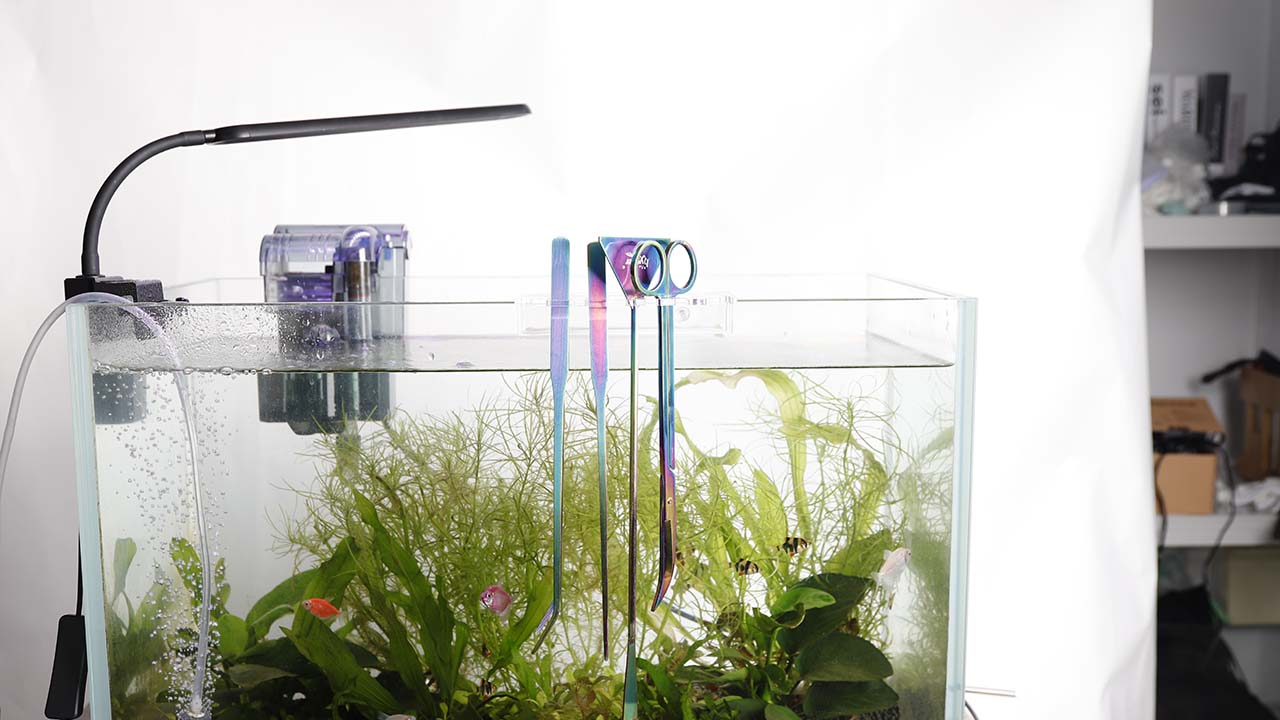
What Tool Is Best Used to Trim an Aquarium Plant
Proper tools are important for trimming and pruning aquatic plants. Here, the hygger tool kit will help you, for instance, the hygger 965 and the 030. These tools are multi-functional and have various features and unique characteristics.
Function
This aquascaping tool kit has a straight and curved tweezer, a long-handle scissor, and a sand spatula. Here are the functions of each tool.
- Straight Tweezer
It helps in adjusting, placing, and removing small objects within the aquarium. Its pointed and precise tip also helps in the plantation.
- Curved Tweezer
It’s the same as a straight tweezer but helps to handle and access inaccessible places in the aquarium, i.e., narrow space.
- Curved Scissor
This scissors tool helps to trim the plant with precision, ease, and accuracy. It specifically helps when it comes to trim a plant in some narrow space.
- Sand Spatula
It helps to smooth the substrate without deteriorating the aquarium ecosystem.
- Cleaning Cloth
This helps to dry the tools after use without scratching the surface. Moreover, it also helps to clean the aquarium surface.
Features
Here are some features of the Hygger 965/030 tool kit.
| Material | Premium Stainless Steel | ||
| Scissors Length | 10.6 Inches | Straight Tweezers Length | 10.6 Inches |
| Sand Spatula Length | 12.5 Inches | Curved Tweezers Length | 10.6 Inches |
Characteristics
Here are some characteristics of the aquarium tool kit.
- Wide Application
This tool kit encapsulates numerous tools that have a wide range of applications. It helps to trim the plants, adjust the substrate, and handle the objects within the aquarium.
- Beginner Friendly
These are some of the best tools and are easy to use. It makes them beginner-friendly.
- Protective Ends
It comes with protective caps that cover the tooltips and help to protect the owner from injury and ensure safety.
- Anti-rust and Anti-corrosion Material
Tools are built with premium stainless steel. It makes them corrosion-free. Moreover, black spray paint and the color steel make them rust-free. However, make sure to dry the tool’s surface after each use.
What Are the Best Aquarium Shears for Pruning?
When it comes to plant trimming shear, Hygger Carbon Steel Trimming Scissors help you to do your job at your best. It has sharp curved blades that help you trim and prune the plant’s surface with ease and excellence. You can maintain the shape of your plants with ease. It is among the best shear options for stem plants.
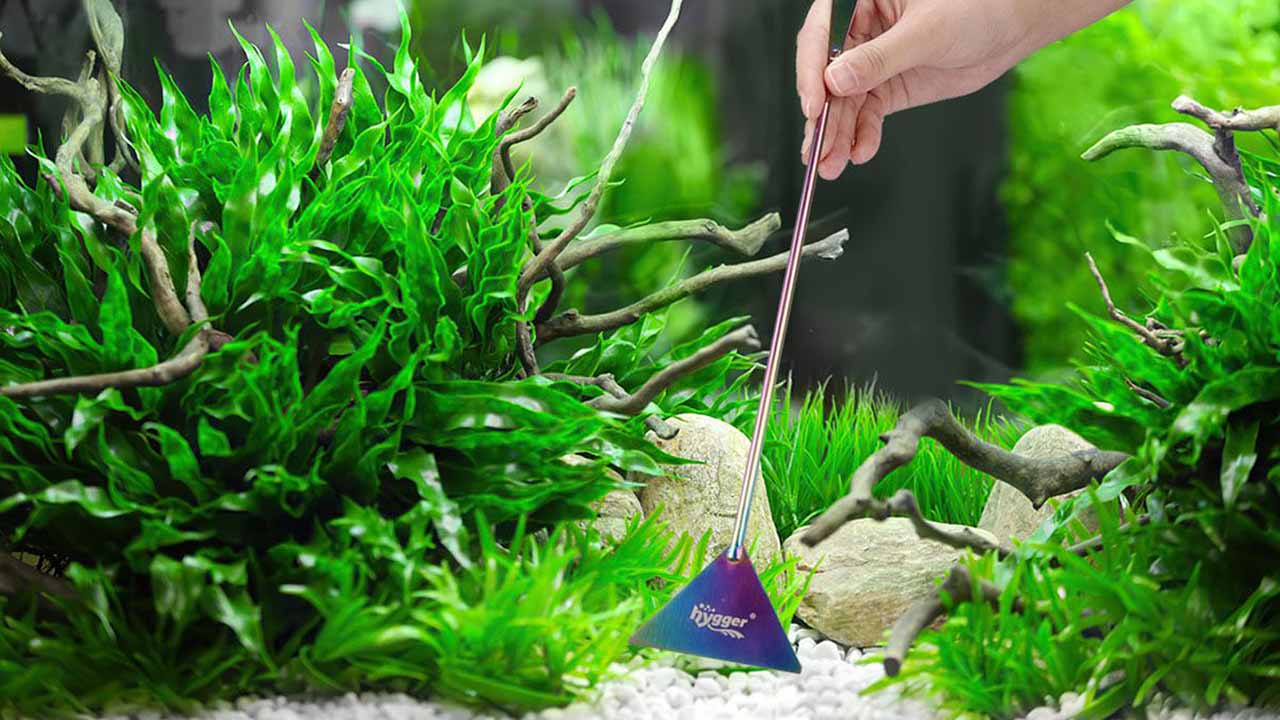
How to Trim Aquatic Plants
There are certain types of plants that you can grow in the tank, i.e., stem, ground covers, and java moss. All of these require specific ways to trim with the help of proper plant-trimming tools. In the following, you will learn the ways to trim your tank’s vegetation and trimming frequency.
Plant Trimming
Here are different aqua-spacing plants with suitable trimming methods and proper plant trimming tools.
- Stem Plant
Trim the longest stem by leaving the lowest leave on the stem. It’ll help in bushy growth and desired height. Use sharp scissors to do the job.
- Ground Cover
Trim the ground cover by leaving just a few centimeters above the ground. It’ll help in spreading a dense carpet on the substrate. Spring scissors and special wave cutters are the best trimming tools to do this job.
- Moss
Trim the bottom layer like you cut the grass with your lawn mover. It helps to grow new and healthy moss layers. Scissors help to achieve this goal at best.
- Decaying Leaves
Use scissors to trim the decaying, damaging, or rotting leaves and move them with a fish net. It’ll enhance the aesthetics and encourage new plant growth.
Trimming Frequency
Trimming frequency depends upon several factors. The factor that decides the trimming frequency are the following.
| Light intensity and duration | The CO2 level in the tank |
| How much fertilizer you are using | The type of the plant |
However, usually, it takes to trim your plants after each 2 weeks, depending on the condition.
Trimming Extent
It’s optimal to trim about ⅔ down to the stem of the plants with the proper plant trimming tool. It’ll help the plants to get adequate light and optimal growth.
After trimming, What to Do
After trimming the plants, here are some things that you need to do.
- Rinse the plants to remove the debris and little leftovers on the plants.
- Use a fish net to remove the floating debris in the tank.
- Remove some leaves from the bottom stem. It’ll pace up the plant growth.
- Re-plant the trimmed stems or branches in the aquarium. It’ll promote dense growth.
- If you are using a sponge filter, then replace or wash the filter media.
- Provide proper lighting, fertilizer, and CO2 (if required).
- Monitor the water parameters, i.e., pH, hardness, salinity, etc.
Conclusion
Aquascaping helps to make your tank the focal point of any space. You have to keep an eye on the light, substrate, water parameters, fertilizer application, CO2, and temperature of your planted tank. Trimming is one of the inevitable aspects of aquarium care that helps to improve proper growth and many other aspects.
Several aquarium plant tools make your job easy. The hygger 965/030 tool kit is such an aquarium tool kit. In this tool kit, specialized plant trimming tools, i.e., curved scissors and two types of tweezers, are present. Use these beginner-friendly planted aquarium tools and make your tank a better place to live for fish.
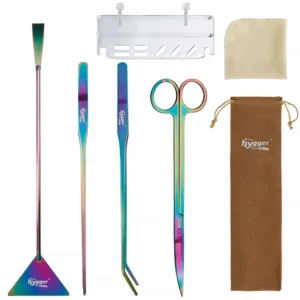
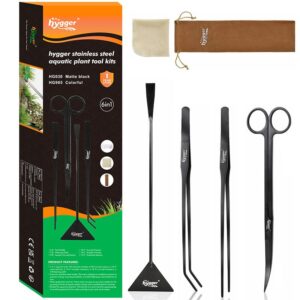
Leave a comment